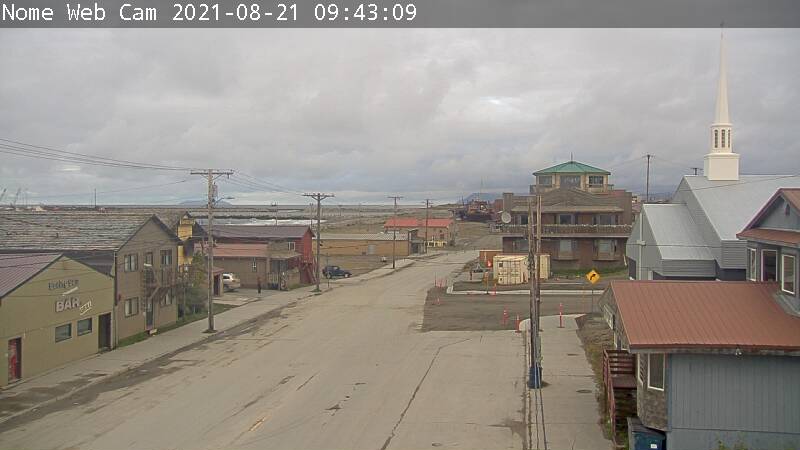

An Unedited View of Alaskan Operations in the Eyes (only) of the Blogger
August 24, 2013
This is the first of many Blogs regarding our mining adventure in Alaska. It is somewhat late in its inception but pictures, website changes and just lack of time have made it difficult to keep the nuggets in the air in our attempt to juggle all components of a remote business operation. So without further verbiage, let me put things in perspective.
How are we doing? Good, but not as good as we hoped.
The mining crew arrived in Nome on the 11th of June. They removed the barged equipment (Nodwell (purchased from the US Navy’s Antarctic Expedition), a Hitachi 400 excavator, and one 20 foot container). They also moved the large processing plant, pumps, and hose out of Nome storage and managed to get all to the mine site through high water, river ice benches, and miles of bogs and mud holes. There were modification requirements needed on the processing plant and most of the other equipment and site preparation for mining and actual gold mining officially began on July 7, 2013.
Our first cleanup after 20 hours of production was quite encouraging at 44 ounces. This was in an area just across the creek to the east of the mining camp where Mike Peckenpaugh had originally cleared the property for surface mining. It was a narrow strip but very rich. It extended for the next cleanup to an area where we had left off with the little plant a year earlier. At that point the canyon narrowed and a decision had to me made as to where to go next.
North or South? – that was the question.
We originally filed for permits going north to what is commonly called the American Creek crossroad. From all indications it appeared the gold channel fanned out at this point before entering the massive alluvial plan that Sherette Creek flows through. With alluvial fanning the big production plant could operate here for several weeks at high efficiency – less time moving. An acre was cleared in preparation and sampling. Sampling was disappointing as the channel did not fan out but remained narrow and isolated – probably due to an underground glacial stream (my thoughts). Nevertheless, the gravel still showed profit per yard but without plant maximum efficiency and production would be higher in this area due to less confinement if moving south to Iron Peak.
Moving south to Iron Peak meant working in a narrow canyon. We did have the lake that we could pull all the water we needed already in place and the creek was dry (an unusual opportunity). The question then was how long would it remain dry? Since we were already in the canyon and time was needed to repair and adjust the equipment and plant, the decision was made to move south with (2) ten three man crew on each shift until we were rained out. Turned out to be a very good decision as the month of July was very dry without hardly any rain. So dry in fact the camp ran out of camp water but the lake kept the mining going. If going north was the decision, we would have been without water and ended up back in the canyon anyway.
Canyon south to Iron Peak – results.
It is important to note that the narrow canyon and gold bearing gravel was in a narrow strip about 3 feet in depth which made the large plant rather inefficient due to quick processing and continuous moving every half an hour to an hour. Moving required a 30 foot backup, pump turned off and on, and leveling and other little things. There was also breakdowns, cleanups and a myriad of oddities that swallowed time in chunks hard to account for.
The plant was in production for 19 days in July. Some days were double shift and some single (breakdowns, fuel, cleanup, etc). Generally, the average feed time per day was 15 hours although a 20 hour shift was completed. Dry weight production for this time frame was 405 ounces. Four days in August (single shift) not included but subsequently produced another 40 ounces.
The rains came in the last days of the first week in August and the equipment was removed from the canyon and taken back to the camp site for repair and modification. Of interest is where the mining stopped in the canyon. The old miners (more than a hundred years ago) had dug a ditch from Sherette Creek up the east side of the Canyon to feed there mining operations in the canyon. Our mining this year stopped at the mouth of this ditch. All the ground mined had already been mined at least once by the old miners and we commonly found their mercury in our gold. The last cleanup produced more large nuggets than any before which indicates that we had begun to finally mine virgin ground.
The distance mined this year for July and first week in August was almost a mile. The best ground was at the camp site just before a massive bend in the creek – undoubtedly the best area in this stretch. There are several miles left to go to the south towards Iron Peak. This appears to be all virgin ground. A smaller and more efficient plant would be ideal for this area in the future.
August – repairs, modifications, and new site development.
After pulling the equipment and plant out of the canyon, a weeks’ worth of maintenance and repair ensued while Jack flew south to get more crew to triple shift in eight hour increments. In the meantime, reclamation was completed on the canyon and around the lake and site preparation to the north began. Ponds had to be made, tundra and willows cleared and a bypass ditch was dug. The Hitachi 400 started giving us trouble and was jury rigged with toggle switches until a new computer could be had and replaced. The Morooka used to haul fuel is in bad shape with substantial repairs needed at some time in the future. Hopefully we can get through the next few weeks. Please keep in mind that no equipment runs very long (new, old, used, super, obsolete). It all breaks when moving this kind of volume. The mining crew is the glue that keeps it going with their knowledge of equipment, tooling, and common sense.
August production started a week ago.
Heading north to the other side of the bend about a mile north of the camp, production started a week ago using triple shifts. Although two cleanups have proven disappointing, the three crews are getting better at recognizing the gold channel and hourly dilution is improving. It is very difficult to see the channel unless you have a trained eye and an extra sense for it. Ivan has described it to me and showed me but I have to admit, I cannot see it. Nevertheless with Ivan and Jack’s instructions it will not take long before production improves and is expected to do so over the next several weeks. Things are running smoother, the camp and food is improving constantly, and some fresh blood (new employees) in production and repair has made it easier on those that have been there for a while.
Other
Well, it is hard to explain the complexities of this mining operation. First of all you have permitting, then MSHA compliance (safety), logistics, travel, fuel, claim staking, filing, and fees. Communications, internet problems (still trying to get two cameras to work), employee difficulties, payroll, getting them paid where they want it, and keeping everyone informed is a monumental task. Just doing the claim staking paperwork for the stakes took a week for 3500 acres. Overall, things do get done and although mother earth has not given us a really good cleanup, it will not be long before we work our way to the hidden bonanza – probably after we get out of this “already been mined channel”. Things should improve over the next few weeks and I will be able to keep you informed better. Please see the next aublog.tom to get an idea of the new pictures and videos.
.jpg)
.jpg)
.jpg)
.jpg)
.jpg)
.jpg)
.jpg)
.jpg)
.jpg)
.jpg)
.jpg)
.jpg)
.jpg)
.jpg)
.jpg)
.jpg)



![[Most Recent Quotes from www.kitco.com]](http://www.kitconet.com/charts/metals/gold/t24_au_en_usoz_2.gif)